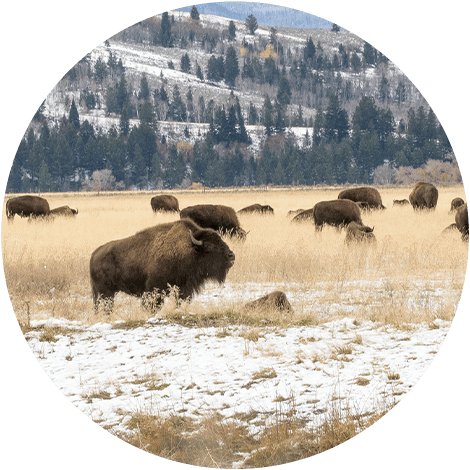Healing with Buffalo
We Can Heal the Land and Heal Ourselves
Tribal Buffalo restoration is about healing. Historically the Buffalo was removed from our lands and our lives, but today the Buffalo is back. They have begun to heal the land with their return, and they are entering our lives once again.

Healing the Wind River
The Buffalo species of the past played a large role in forming the landscape we’ve come to know today. As they wallow, they help create habitat for birds and insects, spread seeds, and the depressions pool water which is important for groundwater recharge and soil nutrient cycling.
They’re ecosystem engineers, setting new healthy growth in motion that we are able to measure over time. With Buffalo on the Wind River Reservation, we’re seeing the land heal with the return of birds, insects and plants.
Buffalo are a keystone species, they revitalize the landscape, natural habitats, and promote diversity of wildlife at Wind River and throughout the North American plains.
Healing Our Culture
Buffalo was life’s commissary to our grandmas and grandpas. It was food, clothing, shelter, and central to our spiritual and ceremonial belief system prior to colonization. When the Buffalo was eliminated, our ceremonial connection to the animal was nearly severed.
With self-determination of cultural revitalization and language preservation efforts, we must also ensure our young people have a foundation in Buffalo. Tribal sovereignty, self determination, and the future of our communities will be built on maintenance of cultural belief systems.

Our ceremonial belief systems aren’t possible without the Buffalo present. We have to ensure our young people are grounded once again in Buffalo. It’s part of our self-identity.

Healing Ourselves
Buffalo were once vital to the wellbeing of Indigenous communities — and after thousands of years we know they are still in our DNA. As Buffalo once again become our food, we harvest them with reverence, and respectfully utilize the entire animal. Buffalo is the healthiest meat source, alongside our other traditional foods including elk, deer, moose, bighorn sheep, and pronghorn antelope.
Through respectful and ceremonial harvest, we’re teaching our youth about the animal’s many uses, from making tools from bones, tanning the hide, carving horn, making glue and the demonstrating preservation of meat and the nutritious benefits and re-integrating Buffalo back into our diet.
We have not forgotten how to use this animal. It’s important as a meat source, high in protein and vitamins. As we begin to incorporate this animal into our diets again, we’re healing from the inside out.
Healing & Recovery
Buffalo back on the Wind River Reservation signifies change, a return to the beliefs and values held by our grandmas and grandpas. We are helping them so they can once again help us. They are here once again for our nutrition, ceremony and tradition. The Buffalo has been absent from our lives for over 130 years, but the teachings are not forgotten. We need healing. The evidence of loss of connection manifests as addiction, trauma, and unhealthy behaviors that is not part of our traditional belief systems. There is potential for healing and recovery — from addiction or trauma — in finding inspiration from Buffalo and a reconnection to Mother Earth and our relatives found in nature.
There are two programs in Wind River for Tribal members seeking recovery resources: Eastern Shoshone Recovery Program and White Buffalo Recovery Program. We offer visits to the Buffalo herds for individuals and groups in recovery.

“Listen to all the teachers in the woods. Watch the trees, the animals, and all living things – you’ll learn more from them than from books.”

“I really had to dig deep in my own healing. Buffalo and the return to ceremony in my community has been the foundation for my healing. Finding purpose in life that is about compassion and empathy.”
– Jason Baldes, Founder
Learn More About Buffalo
All About Buffalo
History of the Buffalo
Healing with Buffalo
Native Values
Myths & Facts
Science & Research
For Educators
